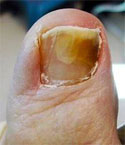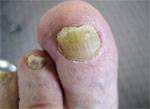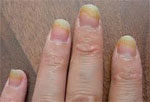Acrylic nail fungus occurs when bacteria becomes trapped and festers between the acrylic and natural nail. Often times, when a woman notices the presence of nail fungus, she wants to conceal it out of embarrassment. The thick, brittle or crumbling nails combined with discoloration can be disheartening. Many feel that masking the problem will make it go away, but nothing could be farther from the truth. In actuality, adding nail polish or acrylic nails may trap the bacteria and allow it to worsen.
Acrylic nail fungus can occur in otherwise healthy nails, but becomes present due to lack of proper hygiene when dealing with acrylic nails. These products are applied to the natural nail in order to give them a lengthy, perfect appearance. However, underneath perfection may be a haven for bacteria. In addition to the normal debris that can be gathered underneath the nail, which is even more possible from the length of acrylics, these products must be secured to the natural nail with some type of sealant.
In some instances, acrylic nail fungus can develop from an individual failing to remove their acrylics as recommended by the manufacturer. If you are going to wear acrylic nails, it is important to follow the instructions completely and pay close attention to any warning labels. The natural nail needs to breathe and the constant application of acrylics can cause nail damage that is beyond repair. It is through damaged nails, cracks and weakening that nail fungus thrives. Bacteria entering underneath the nail and becoming trapped, or not properly removed, are a breeding ground for nail fungus.
The best way to protect against acrylic nail fungus, if you are going to use acrylic nails, is to change the nails as suggested by the manufacturer. Hands should be washed thoroughly and stop using acrylics if you have any noticeable nail damage, including cracks or splits, or if you suspect the presence of nail fungus.
Much like any other nail fungus, acrylic nail fungus feels and looks the same. The main difference is that acrylics cause damage to the nails that may lead to a fungal infection. Anyone who already has been diagnosed with nail fungus should not use acrylics to mask the problem. Those with healthy nails, on the other hand, must use acrylics carefully in order to avoid acrylic nail fungus. There are a variety of treatments available, both commercial and those that require a doctor’s prescription, which is designed to treat all cases of nail fungus whether it be moderate or severe.




